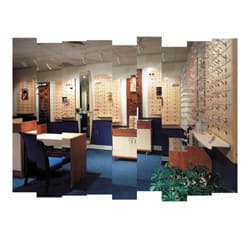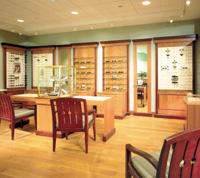Redesign,
Remodel, or Redecorate?
Think your practice needs a face-lift? You can change your look completely or opt for a mere facial without breaking the bank.
By Martine Rothstein
|
|
|
|
|
|
|
New dispensary looks engage patients and staff alike, designs above by Ennco Displays |
Take a good look around your practice. If the last construction or cosmetic work done on your office was prior to 1995, it's time to give your business a fresh look. The good news is that, contrary to popular belief, you can change a lot without having to empty your pockets.
First and foremost, establish your goal. Be it renovation, remodeling, or refreshing, projects should be well-planned, focused on the end result, and designed to follow elementary rules to ensure success. And, don't let what's right under your nose go unnoticed--consider updating your lab and office space, too. Creating a pleasant working environment is a real motivator, though workspace areas are the last consideration for change.
The first step? Call a professional. Doing the job yourself can cost you more than using an expert. Mistakes can cause damage or yield results that are not quite what you expected. Most design houses and optical display/ fixture companies offer soup-to-nuts service, regardless of a project's size.
INITIAL CONSIDERATIONS
Whomever or however you chose to proceed, make sure you take the right steps before you begin:
Budget. Define your budget.
Image. Identify your image--what do you want to project to your customer?
Options. Explore all of your options before you start.
Staff. Consider your office's employee and client flow. And talk to your staff before you make changes.
|
|
|
|
Above Top: Designs should take into consideration the entire environment, from lighting to fabric textures, design by Magic Designs. Bottom: A four-shelf unit from Bright Displays |
Balance. Even on a limited budget, your changes should reflect a balance between old and new. "Design is much more than just product displays and fixtures. It is the total environment, consisting of lighting, colors, and textures of the complete environment," says Neil Freemer, regional manager for Eye Designs in Philadelphia. That means incorporating the new into the old.
IF YOU RENOVATE
The cost of complete renovation can vary dramatically depending upon several factors, including size, location, materials used, tie-ins to existing structures, and any necessary demolition. Some projects start as low as $20 per square foot, and others go well in to the hundreds of dollars per square foot.
Typical costs. Designers report that the normal range of renovation costs for a 2,500 to 3,000 square foot store is around $30 per square foot.
Lease negotiations. To reduce these upfront costs, retailers often try to negotiate leases whereby the landlord does all or a majority of the work in return for increased rent and or a longer lease term.
Site manager. Once the renovation begins, it is critical to have a person on-site to oversee the process. Not attending to this is risky and increases your chances of substandard work, delays, and cost overruns. Your on-site person should be responsible for supervising workloads, expediting tasks, and resolving scheduling delays.
Zoning. Delays are common in the construction/renovation business and can be extremely costly. Make sure that your contractor is on the ball with subcontractors and zoning.
Zoning boards can hold up a project for such reasons as prohibited signage, non-compliance with federal ADA (Americans with Disabilities Act) laws, and corrections that need to be approved. Observance of original plans and drawings is a benefit. Municipal boards do not like to see changes made after their approval.
IF YOU REDECORATE
Redecorating is much more cost efficient and less messy. You can plan your progress in stages according to your budget. And remember what design experts say: Your investment is exactly that, an investment. Changing or updating part or all of your current look can really give your bottom line--and your employee morale--a boost.
Here's what you can expect to get for various dollar amounts:
For $5,000 to $8,000. Believe it or not, you can do a lot on this budget. If you're in a relatively small space, you can squeeze in fresh paint, new carpet, and simple window treatments. You may even get a couple of smaller new displays or a wall display if you plan right.
For $10,000 to $15,000. Along with the above, add new lights and a new graphic (or mirror) or two. Or, use those extra dollars and plan a separate sun island or promotional area.
For $20,000 and beyond. This covers replacing your cabinetry, fixtures, and some furniture.
A practice with 500 to 700 frames on display can replace all of its fixtures for about $25,000. "The biggest thing that makes a difference is getting your frames off those ancient boards and into a cabinet with halogen lighting and a more modern style," says Justine Kish of Ennco Display in Redmond, Wash.
|
|
|
|
A fresh coat of paint in today's "in" colors can breathe new life into a dispensary, but consider your patients when deciding on new color schemes. Seniors are happy with soft colors and woods, while families thrive in colorful, kid-oriented settings. Designs above by Eye Designs |
|
FRESH PAINT
A fresh coat of paint can create a whole new look.
Coverage per gallon. Theoretically, you need one gallon for every 200-400 square feet of flat surface. This means you can get a lot of coverage for a minimum price.
Contrasting colors. Colors can make all the difference. If you are using existing furnishings and fixtures, make sure to color coordinate.
Contrasting colors do not mean it is not well coordinated. Complimentary contrasts really liven things up, and color has subliminal influences on customers as well (see The Psychology of Color on p. 86)
"In" colors. Earthy and natural colors are the "in" colors right now. These tones evoke a sense of calm and sophistication.
Demographic preferences. Before you decide on colors, take your patients into consideration, suggests Lori Estrada, a designer at Fashion Optical Display. "Seniors tend to like woods or soft colors--a look that's comfortable and user friendly, not glitzy. Younger families like to see things geared toward kids--a play area and separate frame section. These are usually more colorful, possibly using more laminates and brighter wall coverings."
Kids area. While looking at your layout, think about special colors or paint for a children's area. For example, chalk board paint is available in colors like black, green, and red, but can also be found in paler hues.
LIGHTING CONSIDERATIONS
Lights serve a dual function--brightness and lighting. Understanding the difference is needed for a correct balance.
Brightness. Brightness affects the outside and inside. An over-lit store creates a harsh or institutional feel, while an under-lit store can be foreboding and unwelcoming.
Display lighting. Natural light is best--not only is it cheaper, but it is more flattering. Lights also affect your display windows. If you're using interior-store lighting for your windows, you're missing a great visual. Instead, invest in a few direct lights for your displays.
Fluorescent lights. Sandra Bright, owner of Bright Display in Woodinville, Wash., says, "I advise my clients to use florescent lighting as it produces soft, diffused, almost shadowless lighting." She recommends moving the lighting to start about six inches from the back of your shelving, and investing in new diffused panels that update the look.
Bulbs. Spotlights, halogens--even goose-necked table lamps on top of your dispensing area--make for decorative ways to highlight and enhance your objectives. Light bulbs throw color, so make sure you are using bulbs that duplicate natural light and not a harsh blue or yellow tone.
Conserving power. Proper lighting can even reduce your energy consumption and increase productivity. Almost 90 percent of the electricity used for lighting is turned into heat, so in the warmer months, using the wrong lighting can cause a need for more air conditioning.
Costs. On average, hiring an electrician will run you from $45 to $70 per hour (depending on their level of expertise, availability, and job duration). Light fixtures themselves cost from around $20 and up. If you are not sure about what to use, there are lighting consultants who deal only in that area.
|
|
|
|
Updating piece-by-piece is a money-saving option. Case by Fashion Optical Display |
SPACE CONSIDERATIONS
Look at your floor plan! Does it flow? Are you really using your space?
Floor plan. Anne Hersh, owner of Block and Zuckerman in West Orange, New Jersey, recently redecorated and says that mapping out her floor plan on graph paper really helped.
"I wanted to be sure I was using every square inch to its maximum potential," she recalls. "The floor plan was invaluable, helping me see my office from a different perspective."
Safety. If you have an elderly clientele or lots of young children, make sure your furniture and fixtures are sturdy and that customers can easily navigate around them. Too many freestanding pieces can be hazardous.
Mirrors. Mirrors are a great way to make a small space seem larger. Just keep in mind that too many mirrors can be disorienting.
Vertical space. Don't forget to take advantage of vertical space with stacked shelving, high cases, and fixtures. Eye level is key for successful selling, so anything above or below should be reserved for request or specific sales items.
DISPLAYS AND FURNISHINGS
Look around and make sure your current fixtures are functional.
Mixing old and new. New fixtures can vary tremendously in price, so an attractive option to starting from scratch is replacing or adding a few pieces. "It is easy to integrate existing cabinetry with new," says Cy Furman, owner of Magic Design in San Francisco. "Marry the old with the new for great results and the smallest impact on your pocketbook," he advises.
Seating options. Chairs can be one of your most expensive items, so consider recovering old chairs for less than half the cost, suggests Robbin Belzer of Design Concepts in Tampa, Fla. Solid, well-made furnishings can be recovered every few years to update your look often at a nominal expense. Just make sure chairs aren't too soft or too low--both problems for seniors.
Now that you have a better idea of your options, take another look around. You can start improvements today. Hire a new cleaning service, add fresh flowers, or just open the blinds. They're all a great start.
|
DON'T FORGET... |
Here are a few things designers say their customers sometimes forget. Freight. As you are adding up the purchase price of any new materials, don't forget to consider your freight charges. Buying from a local source will help you to save upwards of 10 percent of your purchase. Look up! Are your ceiling tiles or acoustic paneling water-stained or chipped? Tax deductions. Capital improvements can amount to significant tax deductions. In fact, some forms of flooring and demountable floor-to-ceiling walls are considered accelerated depreciation on your taxes. You can find out more from most contractors. Vertical space. You can acquire an additional 10 to 20 percent of useable workspace from your existing area by taking advantage of vertical space. Scheduling work. If you don't plan right, any renovations can affect your traffic flow or business hours. It's important to set a schedule and try to get work done after hours (though it may run you a bit extra), or on days when you're closed. Acoustics. Don't forget that the right combination of furnishings, flooring, and ceiling can reduce your noise level. |










